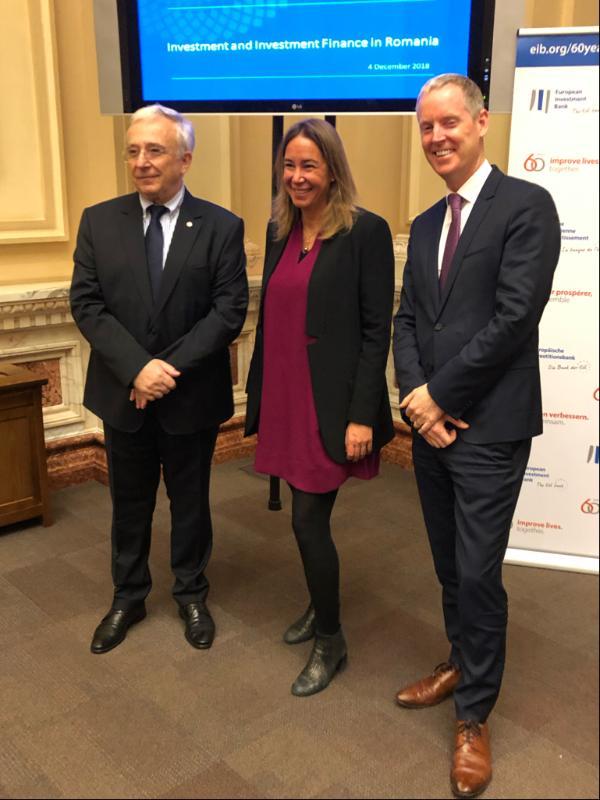
The National Bank of Romania and the European Investment Bank (EIB) held today a joint conference on Investment and Investment Finance in Romania, presenting the main results of the study conducted by the EIB:
- Investment gaps are prevalent despite the strong – but mainly consumption driven – growth in recent years
- Investment activity in Romania remains one of the lowest in the EU: Only 68% of firms invested in the last financial year, compared to 87% EU-wide
- Uncertainty about the future and business and labour market regulations are the most significant barriers to investment
- Innovative high-technology firms are more likely to face difficulties in obtaining external financing
Debora Revoltella, Director of the EIB’s Economics Department, presented the new 2018 results of the annual EIB Investment Survey (EIBIS), which, together with the EIB Investment Report, provides an overview of the cyclical and structural dynamics behind investment and investment financing in Europe.
The day before, the EIB signed an agreement to lend EUR 30m to BCR Leasing, aimed at co-financing leasing projects supporting SMEs and Mid-Caps in Romania. The contract is part of a larger (EUR 100m) operation approved by the EIB, re-confirming an already successful partnership with one of the key players on the financial leasing market in Romania.
EIB Vice-President Andrew McDowell, commented: “The survey, which is conducted across Europe including Romania, provides the EU bank with a powerful policy tool to understand investment plans and needs of public and private companies, and for outlining how the EIB can bring real value to the economy and people. With a large staff here on the ground the EIB stands ready to address existing needs by financing investments carried out by Romanian corporations and state entities.”
The Governor of the Romanian National Bank Mugur Isărescu stated: “The European Investment Bank has been a strong pillar for Romania’s strategic economic development, channeling investments towards the crucial sectors of transport, digital infrastructure and the new technologies, education for skilled labour force, healthcare or agriculture. The European Investment Bank contributes to creating the right mindset and responsible attitude of assuming calculated risks. It supports the communication of sound public policies and priorities for Romania’s economic and social development, to continue and expand the European integration and economic convergence.”
Understanding investment constraints is crucial for Romania to continue its path towards economic convergence. The conference featured a broader debate on investment needs and priorities, the availability of financing sources for investments, in particular the use of EU funds and the role of EIB financial instruments in supporting long-term investment. Moreover, the discussion focused on how Romania could transition to a different growth model and best strengthen innovation going forward.
The EIB Group survey on Investment and Investment Finance – in the case of Romania – provides unique insights into Romanian firms’ investment activity, their plans and views on what holds back investment. The EIBIS reveals that the perceived investment gap – expressing the share of firms that did not invest enough in recent years - is above the EU level (20% vs 16%). This confirms the low investment rate on the macroeconomic level and significantly lower quality of assets. The average share of state-of-the art machinery and equipment in firms is one of the lowest in the EU, as is the share of energy-efficient building stock.
Following a prolonged post-crisis period, with both public and private capital investments staying 30% below the 2008 level, investment growth turned positive in 2017 and expectations improved. Public expenditure prioritization towards consumption and the relatively high leverage of corporations on the private side were the main factors of holding back the investment recovery until last year. Understanding the reasons behind this slow and uneven recovery in investment over the past decade is key to defining appropriate policy interventions in order to confirm and take advantage of a more positive trend.
Firms’ investment remains focused on replacement and tilted towards tangibles. Investment in intangibles is considerably below the EU level (25% vs 36%). A closer look at firms’ innovation activity in Romania shows that among the innovators, most rely on adoption rather than development. “Altogether, this underscores the need to do more in the area and to support a transition towards more innovation-led growth in Romania” according to Debora Revoltella.,
About 12% of firms face finance constraints, and reliance on internal financing sources remains high. Access to finance is more of an issue in Romania than in other EU countries and innovative, high-technology intensive firms face even greater difficulties in successfully tapping external financing. Uncertainty about the future and business and labour market regulations are the main barriers for businesses in Romania. Additionally, the lack of adequate transport infrastructure is more of an obstacle for Romanian firms compared to EU peers. Finding people with the right skills is particularly a challenge for innovative companies.
This country overview presents selected findings based on interviews with 475 firms in Romania in April-August 2018. The survey is part of the annual EIB Group Survey on Investment and Investment Finance (EIBIS), an EU-wide survey of 12 500 firms that gathers quantitative information on the investment activities of both SMEs and larger corporates, their financing requirements and the difficulties they face.

Photographer: Dusan Ondrejicka ©EIB
Download original

Photographer: Dusan Ondrejicka ©EIB
Download original

Photographer: Dusan Ondrejicka ©EIB
Download original